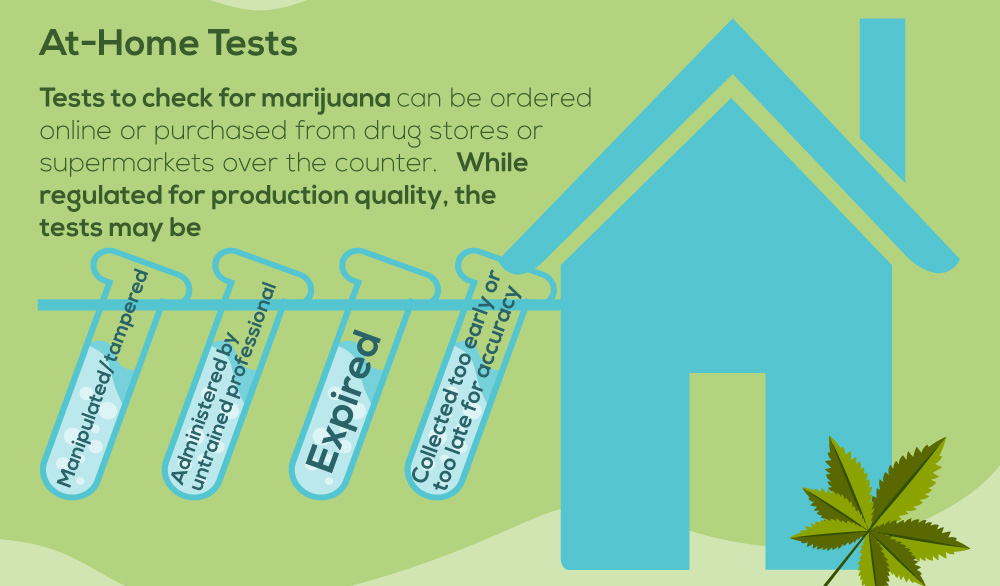
Drug Tests Have Multiple Purposes

- Whether it is legal or not in your state to use marijuana, it is NOT within the law to drive while impaired from any substance. Therefore, police and the court systems will want to uphold the law and may require urine samples if you are charged with driving under the influence.
- Maybe it’s parents of an underage child worried about their school grades going down and their new group of friends. They may choose to go to a pharmacy to purchase an over-the-counter test to use at home the next time their son or daughter breaks curfew.
- Employers often have a drug-use policy for various reasons:
- Either there is heavy equipment being operated, and they must ensure the environment is safe, or they believe working under the influence makes you less productive.
- Or maybe it has to do with their health insurance plan, and one person’s actions affect the other employees’ costs.
- Some employers, perhaps in childcare, may consider it an indicator of your character, and worry about who is supervising children in the facility.
- For federal workers, a marijuana metabolite level cutoff is 50 ng/mL. Other private or public employers may have a no-tolerance policy, a suspension period, or other strike-out enforcement.
- Schools and sports associations often enforce drug screens if they are publicly owned and therefore liable by local and state laws, or are worried about breaking association rules by which players must abide if they want to participate.
All of these factors take into consideration the possible effects one person’s marijuana use may have on others. Therefore, there are multiple types of tests and multiple reasons they are required.
Testing Can Prove Wrong Behavior AND Give an Inaccurate Reflection of Circumstance

Marijuana and Metabolism Challenge Clinical Testing

- THC (tetrahydrocannabinol) level
- How it is consumed (inhaled smoke from leaves, concentrates, extracts, or oils vs. consumed as edible
- Edibles (food such as gummies or brownies or drinks such as tea)
- Inhaled through a joint, vape pen, or water bong (even how deeply it is inhaled and how long it is held in)
- Frequency of consumption
Metabolism Plays a Critical Role for Cannabis Processing
According to Dr. Robert Mann of the Centre for Addiction and Mental Health, in a 2019 Global Newsarticle, “When you use cannabis, the THC gets absorbed into the fat in your body, and so there’s kind of a reservoir there that keeps getting released fairly slowly, so that you will find trace amounts of THC in the blood for a longer period but at very low levels.”
Types of Marijuana Testing
There are a few dynamics that determine whether you will undergo a blood or urine test:
- How quickly the results are needed
- If the test site is set up to handle multiple appointments
- Ability to process urine/blood samples
- Precision of results
- Test expense
Clinical Studies Provide Limited Detection Data

Marijuana Testing Accuracy Has Several Flaws
According to the journal Therapeutic Drug Monitoring, in 2004 it published an article regarding the types of drug test administered, “in general, the detection time is longest in hair, followed by urine, sweat, oral fluid, and blood.”
Urine Test
Referred to medically as immunoassay tests, urine tests can confirm or deny if marijuana is detected. It cannot indicate how much marijuana is present. Inaccuracies may cause false positives with this fairly quick and less expensive test. The test results can undergo further analysis with a gas chromatography/mass spectrometry (GCMS) follow-up. Rarely will a GCMS result in a false positive. However, both a urine screen and a GCMS analysis can give a negative result, even if there is drug use and even if it was the same day.
Blood Test
Using a syringe to retrieve a blood sample generally proves to be more accurate than a urine test. Blood tests can gauge a better result for marijuana concentration levels in addition to confirming whether marijuana is even present.
Saliva
A mouth swab is an easy way to administer a test for marijuana. Both parties are in full view of each other, and possibly others, so evidence-tampering is minimal. For this reason, they are growing in popularity with some police agencies and job sites.
Breast Milk
THC can be detected in breast milk from a nursing mother. If detected, doctors are required to report suspicion of cannabis use to the local department of family and children’s services.
Hair Follicle Test
Analyzing a hair sample can detect whether marijuana is present and typically gives the longest window of possible use. On the other hand, if marijuana was only used in the previous week and not earlier, due to hair growth it most likely cannot be detected. Because the test analyzes the follicle, hair dye or other products won’t alter the results. A Friends Research Institute 2015 study of 360 self-reported adult marijuana users found the hair test to be 52.3% accurate.
At-Home Tests
Tests to check for marijuana can be ordered online or purchased from drug stores or supermarkets over-the-counter. These at-home tests were given the okay by the Food and Drug Administration (FDA) in 1997. 
- Manipulated or tampered with if the sample is not supervised throughout the process
- Administered by an untrained professional
- Expired
- Affected by collecting sample too early or too late for accuracy
Who uses these tests? Some people may want to do a self-check of their results before going to a testing site. Other times, a parent or spouse may ask a child or partner to complete a test if there is suspicion of use.
Pain Clinics and Substance Treatment Centers
Office settings where urine tests are undergone have been growing as onsite point-of-care-testing. This is done to ensure compliance by the person seeking treatment promised by the provider. While they are cleared by the FDA, they are sometimes subject to fewer requirements and might use subjective visual analysis to evaluate sample coloring. In this situation, the simple presence or absence of a substance is the typical standard of data collection.
Drug Results Rely on a Trained Eye for Evaluation
Someone worried about a drug test result can become desperate in their attempt to conceal their marijuana use.
- It could cost them their job and bring financial consequences or public humiliation.
- A teen may be terrified of their parents’ reactions and possible punishments.
- Someone on probation may be at risk of serving a suspended jail sentence.
Unfortunately, this fear mindset might make them do something they wouldn’t ordinarily consider. They may have been at a party and someone passed them a joint, and in a moment of recklessness they chose to participate, not thinking about the after-effects. Now, they’re seriously considering altering their urine sample by drinking vinegar or even detergent, eating table salt, or buying an online masking agent such as the aptly named Urine Luck. Someone familiar with urine’s normal pH level and creatinine levels would be able to identify if they’re working with a usable sample.
Finding Inpatient Marijuana Drug Rehab for Recovery
It’s not news that the opinions of legalization and use of marijuana are evolving based on the philosophy it can have medical merit and successfully be used for harmless recreation. But like anything, overindulgence is not helpful when done consistently.When considering the nuances involved with accurate testing, you should also consider if marijuana use is affecting your life:
- Does it cause you to make poor decisions such as driving under the influence?
- Is your wallet being drained to support your habit?
- Is chronic use making you ill, specifically to the point of inducing vomit? Do you continue to use marijuana knowing you will be ill?
- Do you experience withdrawal symptoms such as sleep problems, irritability, anxiousness, depression, or decreased appetite?
- Do you have problems in your social, work, or school life due to use?
- Do you use larger amounts for longer periods than intended? Is it difficult to cut back?
These are some examples, but not all of the criteria, used when considering cannabis use disorder diagnosis.If you are concerned about your use or that of someone you love, reach out about marijuana rehab, we understand these are murky waters you are navigating. By calling Northpoint Recovery Idaho to discuss your unique situation, we can begin to assess you and share our care plan strategies. We have a long-standing reputation of being a quality, evidence-based drug rehab center. Let us help you and your family. Call us at 208.486.0130.
FAQs
How long can marijuana be detected in a urine test, and can you avoid detection?
If you rarely use marijuana vs. being a chronic user, it will significantly affect your urine test. You may test positive three days after one-time use and negative the next day. If you use it frequently, it can be detected in your urine weeks later. Attempts to dilute urine or change the pH by adding solutions may just make the test inconclusive and a retake can be ordered.
How long is the detection window for marijuana?
In order of testing methods, a hair sample is the longest detection period and can show use up to 90 days after marijuana has been consumed. One-time use of marijuana can be detected roughly three days after use through urine or blood. Oddly enough, a hair test might show a negative result for a one-time use within seven days because of the growth rate.
How long does it take to have a clean marijuana mouth swab detection time?
While a saliva test can detect marijuana within 30 minutes of use, its window is relatively short and generally can no longer be detected after 48 hours.
What Did you Think About This Blog?
Give it a Rating!



